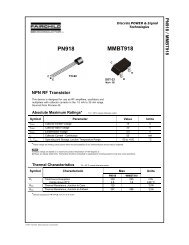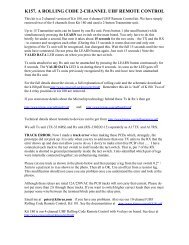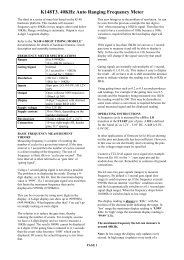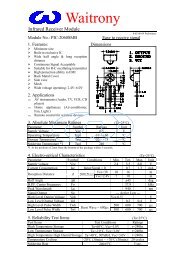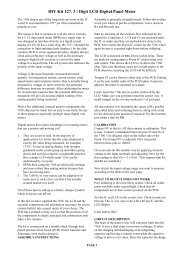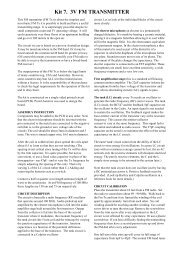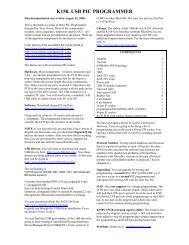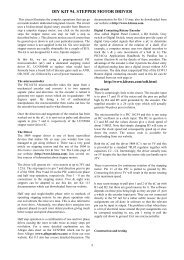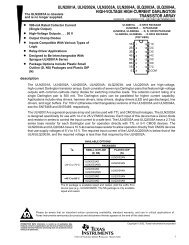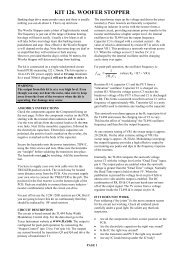A Rolling Code 4-channel UHF Remote Control - Kitsrus
A Rolling Code 4-channel UHF Remote Control - Kitsrus
A Rolling Code 4-channel UHF Remote Control - Kitsrus
Create successful ePaper yourself
Turn your PDF publications into a flip-book with our unique Google optimized e-Paper software.
We’ve presented a number of<br />
remote (radio) control devices<br />
in the past. None has<br />
been more secure than this one. To<br />
guess the code combination, you’re<br />
going to need something like 23 billion<br />
years. But don’t bother: the next<br />
time it’s used, the code will have<br />
changed anyway.<br />
That’s the advantage of a rolling<br />
code (or “code hopping”) system. We<br />
explain what this means, and does,<br />
later in this article.<br />
Suffice to say at this stage that it<br />
makes one v-e-r-y secure system. For<br />
all intents and purposes, it is impossible<br />
to electronically “crack”. Go on,<br />
give it a go – we’ll see you in a few<br />
million years or so!<br />
The transmitter<br />
It’s probably not necessary to say it<br />
but there are two parts to this project,<br />
a transmitter and a receiver.<br />
First of all, there is<br />
the tiny 4-<strong>channel</strong><br />
“key-ring” transmitter<br />
which, fortunately,<br />
comes 99% preassembled.<br />
We say fortunately<br />
because it’s just<br />
about all SMD (surface<br />
mount devices)<br />
which, while not<br />
impossible for the<br />
hobbyist to work<br />
with, requires some<br />
rather special handling.<br />
You are<br />
spared that!<br />
All you have to<br />
do with the transmitter<br />
PC board is<br />
solder on the two<br />
battery connectors<br />
and place it in the case (with battery).<br />
The battery contacts are slightly different:<br />
the one with a spring is for the<br />
negative battery connection – it goes<br />
on the righthand side of the PC board<br />
with the only straight side of the PC<br />
board at the bottom.<br />
You may find, as we did, that some<br />
of the holes for the battery connectors<br />
are filled with solder. This is easily<br />
melted during installation.<br />
Once this is done, it’s just a matter of<br />
assembling the board in its keyring case.<br />
Incidentally, the keyring case and battery<br />
are all supplied in the kit.<br />
The transmitter itself is in the licence-free<br />
433MHz LIPD band (it’s<br />
SPECIFICATIONS<br />
• <strong>UHF</strong> (433MHz) licence-free (LIPD band) operation<br />
• Long range – prototype tested to 100m+<br />
• Pre-built and aligned transmitter & receiver modules<br />
• <strong>Rolling</strong>-code (“code hopping”) operation (7.3 x 10 19 codes)<br />
• Receiver “learns” transmitter coding<br />
• Receiver can handle up to 16 remotes<br />
• Transmitter can handle any number of receivers<br />
• 4 <strong>channel</strong>s available, each either momentary (push on, release<br />
off) or latching (push on, push off) via jumpers<br />
• <strong>Code</strong> acknowledge LED and <strong>channel</strong> status LEDs<br />
• Each <strong>channel</strong> relay contacts rated at 28VDC/12A (single pole,<br />
changeover)<br />
actually on 433.9MHz). As with most<br />
devices of this type these days, it is<br />
based on a SAW resonator (that stands<br />
for surface acoustic wave, so now you<br />
know!). This keeps the circuit very<br />
simple but enables excellent performance.<br />
Without wanting to get into the<br />
nitty-gritty of SAW resonator operation,<br />
in essence it controls the RF side<br />
of things while a dedicated chip controls<br />
the complex digital coding.<br />
The receiver (which we’ll get to<br />
shortly) can handle up to 16 transmitters<br />
so if you have a really big family<br />
or maybe have a secure company<br />
carpark you want to give a certain<br />
number of people access to, you can<br />
do so simply by purchasing more<br />
transmitters.<br />
The transmitter has four pushbuttons,<br />
one for each of the four <strong>channel</strong>s.<br />
Of course you don’t have to use all<br />
four <strong>channel</strong>s – just one will control<br />
• 12V DC operation (6mA quiescent; 150mA all relays actuated)<br />
most garage door openers, for example<br />
– but it’s nice to know there are<br />
four <strong>channel</strong>s available.<br />
And before we move off the transmitter,<br />
up to three <strong>channel</strong>s can be<br />
pressed simultaneously and the receiver<br />
will react to all three (it won’t<br />
handle four at once, though).<br />
Finally, as well as multiple transmitters,<br />
you can use more than one<br />
receiver if you wish.<br />
Each receiver “learns” its transmitter(s)<br />
so you can have a multiple<br />
system controlling, for example, the<br />
garage door, the car doors, the car<br />
alarm, the home security system – in<br />
fact, anything your little heart desires.<br />
The receiver/decoder<br />
Now we move on to the heart of the<br />
system, at least the bits you have to<br />
put together to make it work.<br />
In fact, there are two parts to the<br />
receiver as well. There is a 433MHz<br />
receiver module which comes assembled,<br />
aligned and ready to go. This<br />
solders into an appropriate set of holes<br />
on the main PC board once you’ve<br />
finished assembling that board.<br />
The main PC board contains the<br />
electronics which process the output<br />
from the receiver.<br />
The receiver checks the incoming<br />
code and if valid, sends a signal to one<br />
of four outputs depending on which<br />
button was pressed on the transmitter).<br />
From here, depending on how the<br />
four jumpers are set on the board, the<br />
signal goes either direct to an NPN<br />
transistor relay driver (for momentary<br />
operation – the relay is energised while<br />
the button remains<br />
pressed) or to a D-<br />
type flipflop and<br />
then to the transistor<br />
relay driver (for<br />
alternate operation –<br />
press once and the<br />
relay latches, press<br />
again and the relay<br />
releases).<br />
The flipflops<br />
change state (toggle)<br />
each time a postive<br />
going pulse appears<br />
at the clock input.<br />
This is achieved by<br />
the connection from<br />
the Q-bar output to<br />
the D input via an RC<br />
network.<br />
The circuit has a<br />
power-up reset. When<br />
power is first applied,<br />
the Q outputs of the flipflops are reset<br />
low by the 0.1µF capacitor and 1MΩ<br />
resistor on the reset (S) inputs.<br />
Reset is caused by sending the reset<br />
inputs of all flipflops high. Once the<br />
capacitor is charged, the voltage at the<br />
reset inputs of the flipflops falls to<br />
virtually zero, allowing normal operation<br />
It is perfectly acceptable to have a<br />
mixture of momentary and latched<br />
modes amongst the four <strong>channel</strong>s. It’s<br />
up to you.<br />
But if you only require momentary<br />
action (for example, as needed by<br />
www.siliconchip.com.au<br />
JULY 2002 19



